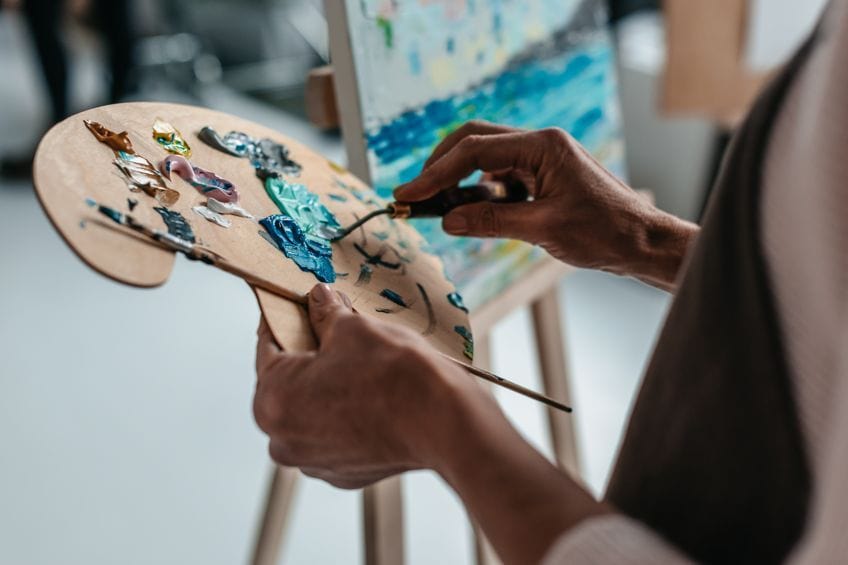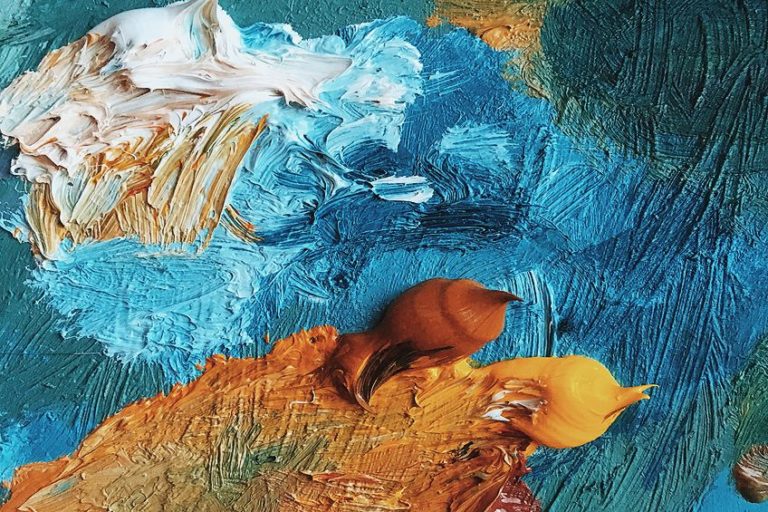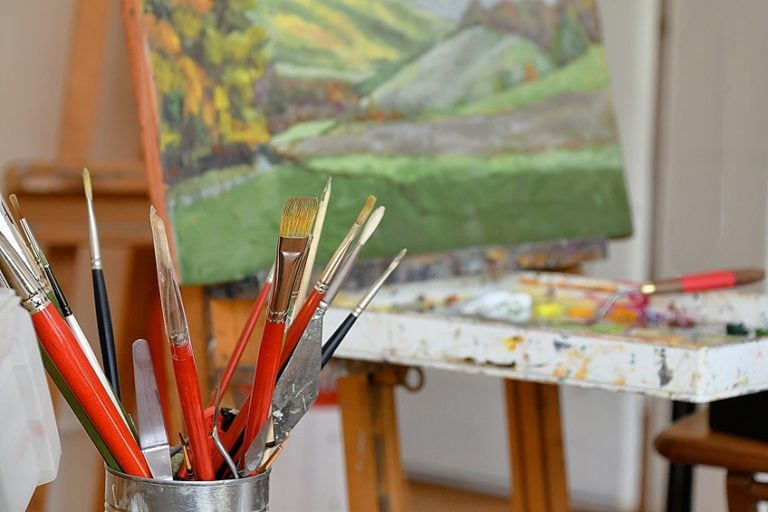What Is Painting? – Discussing the Visual Art of Paint
This post may contain affiliate links. We may earn a small commission from purchases made through them, at no additional cost to you.
Painting is a centuries-old art form that has been practiced since the first humans discovered the function and value of natural mineral pigments. Art was thus born out of curiosity and a desire to create. In this article, we will explore the art form of painting in detail, such that you will have an in-depth understanding of the art form, including its evolution, the different techniques used in painting, and some of the best painters in the world. Read on for more about the incredible practice of painting and all you need to know to begin your art journey!
Table of Contents
An Introduction to Painting: What Is a Painting?
The art of painting is traditionally understood as the process of applying a pigment onto a canvas and calling it a day. While painting is no clear-cut process, there are a multitude of techniques and styles that have emerged over thousands of years, which provide us with more than enough inspiration and examples to review. So, what is painting, and why is painting important?

The art form of painting refers to a diverse medium and visual art form that involves the creation of visual images using coloring agents and other pigments applied to different materials or surfaces. Traditionally, such materials include canvas, paper, walls, and digital screens. In the modern sense, painting encompasses a variety of techniques, styles, and subjects, which reflect the individuality of the artist and showcase the trajectory of the artist’s technical skills over time. Painting is not only a medium for individual artistic expression but it is also a tool for communication in a way that does not rely on spoken or written language, but visual language.
Whether it is a portrait of a politician or a portrait of a common family, painting has never failed to provide scholars with valuable information about a culture, society, or time. Artists have leveraged painting to discover and influence the spread of new art styles such as Impressionism and Abstract Expressionism. Painting is an art form that has defined the genre of art itself and serves as a crucial part of the economy since the art industry is also a revenue generation space that employs art dealers, institutions, curators, and artists alike, which boosts cultural tourism and community engagement.
Below, we will explore further the origins and history of painting by looking at the figures who shaped it and the different painting techniques that emerged since its origin.
A History of Painting
What is a painting, and how did the art form evolve in history? Painting is a significant art form that continues to uplift and benefit societies across the world. We will now dive into a detailed history of painting by examining the origins and evolution of painting as it is understood in the Contemporary era.
 Farmhouse in Provence (1888) by Vincent van Gogh; Vincent van Gogh, Public domain, via Wikimedia Commons
Farmhouse in Provence (1888) by Vincent van Gogh; Vincent van Gogh, Public domain, via Wikimedia Commons
The Origins of Painting
What is painting, and how did it originate? To truly understand painting, it is useful to gain an understanding of its development over time. To summarize a major portion of painting in the history of the world, one can first understand its discovery and purpose. The earliest known paintings date as far back as 40,000 years ago and can be found in cave sites across Europe, most notably in France, as well as the islands of Indonesia. Some have speculated that the pigment ochre, of which a small block was discovered incised, originated as the original medium of early painting in Blombos cave, South Africa around 60,000 years ago.
While the earliest mediums for painting were natural pigments, including rare occurrences of animal blood and vegetable pigment, later mediums evolved to encompass ink in the East and watercolor, and oil paint in the West.
The Evolution of Painting
Initially, painting was a form of documentation and record of human existence and identity to convey the messages of human occupation and travel. Painting was also used to record celestial objects and important earth events that later informed archaeologists’ understanding of human chronology and migration. In terms of stylistic conventions, early paintings were simple in form and were not produced for commercial purposes. The significance of painting was also tied to religious and ceremonial purposes, such that the mediums and process of painting were well-respected in some cultures.
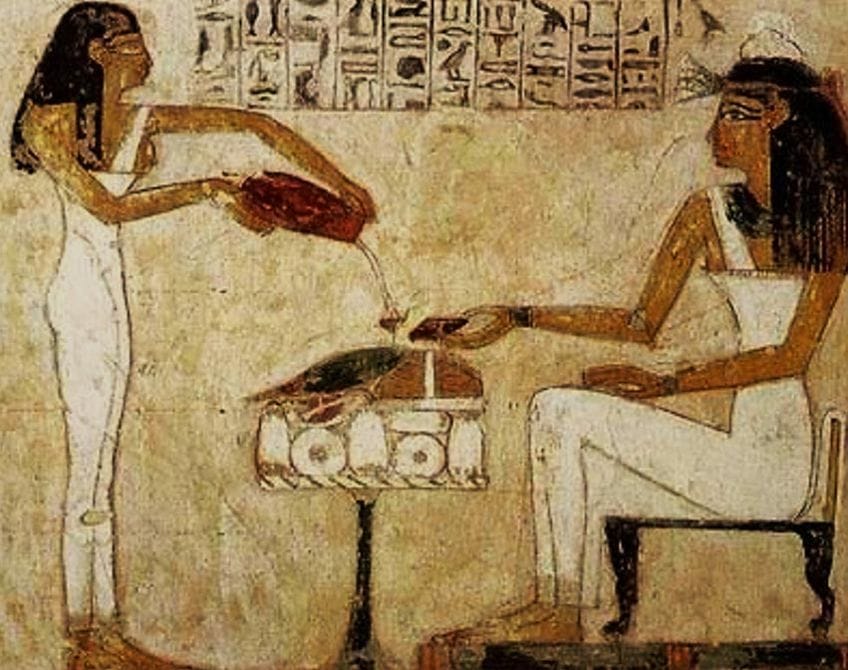 Egyptian hieroglyphics depict the pouring out of beer (nd); See page for author, Public domain, via Wikimedia Commons
Egyptian hieroglyphics depict the pouring out of beer (nd); See page for author, Public domain, via Wikimedia Commons
Aside from its documentative quality, early painting styles evolved to encompass designs and motifs that resemble simple geometric forms such as circles, lines, zigzags, dots, and a combination of patterns with no clear meaning. Painting was representative of simple observable forms, including anthropomorphic figures, which were believed to be induced by hallucinatory herbs and medicines in some cultures. It was evident that painting was a form of expression and representational in its function.
Painting in the Antiquity Era
In visual art, paintings from 3500 BCE saw many ancient civilizations contributing to the development of painting techniques and styles. These include the Egyptians who used natural pigments such as charcoal, minerals, and ochre to create magnificent paintings in temples and tombs. Painting took on a symbolic value and was connected to funerary and religious themes. Ancient Egyptians aided stylization techniques through their invention of hieroglyphics, which incorporated symbols in their paintings.
Famous painters from antiquity include figures like Polygnotus (5th century BCE), Zeuxis (c. 5th-4th century BCE), and Apelles of Kos (4th century BCE).
The Influence of Stylization and the Byzantine
Stylization in art continued in Africa for centuries while painting styles changed and shifted rapidly in Europe and the East. The Byzantine era, which ran from the 4th to the 15th century, saw painting evolve distinctly, as it was dictated by the dominant preferences of the Byzantine Empire. Painting played a major role in religion and was featured in many religious buildings to promote the iconographies of the time. Egg tempera paint was popular in this period and was used to create the highly stylized aesthetic of Byzantine art, characterized by frontal portraits, hieratic poses, and gold backgrounds. Famous painters from the Byzantine era include Manuel Panselinos (13th century), Andrei Rublev (14th century), and Giotto di Bondone (14th century).
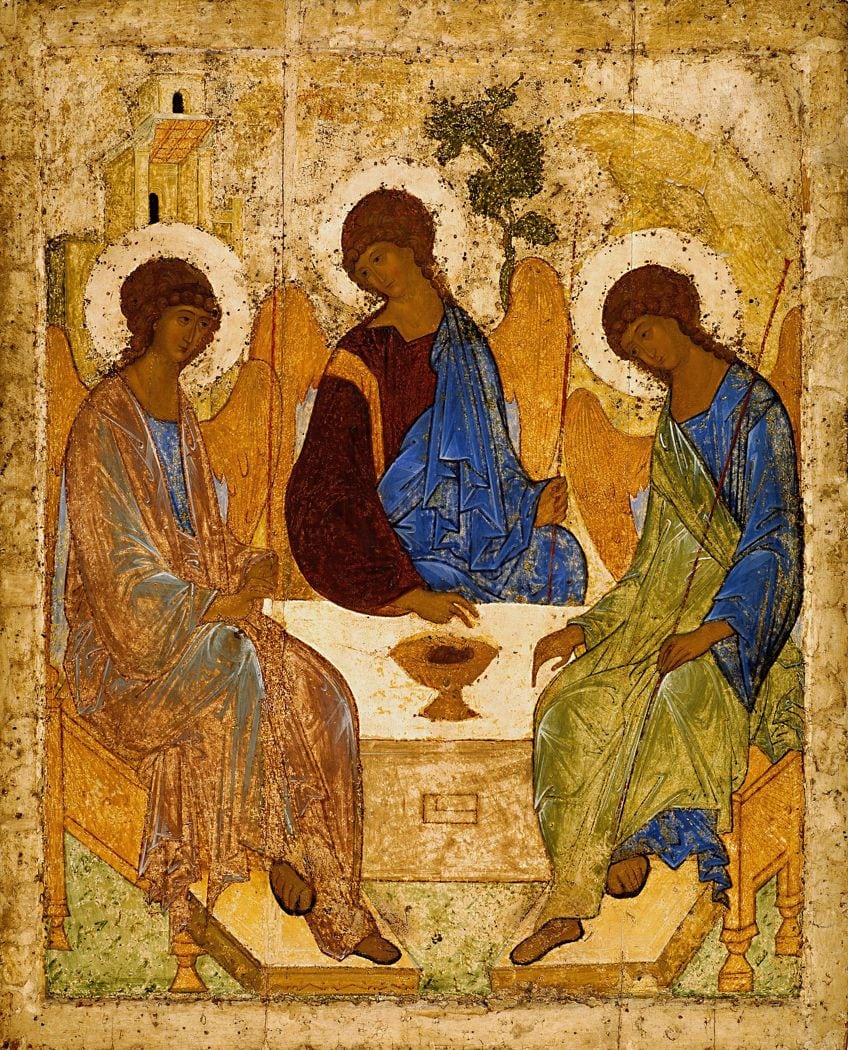 Holy Trinity (1427) by Andrei Rublev; Andrei Rublev, Public domain, via Wikimedia Commons
Holy Trinity (1427) by Andrei Rublev; Andrei Rublev, Public domain, via Wikimedia Commons
Painting in the Middle East and East Asia
Middle Eastern painting evolved through Islamic art, which included calligraphy, abstract designs, and geometric patterns. Islamic paintings were created for religious and decorative purposes and included miniature paintings with religious manuscripts. In East Asia, painting in China and Japan evolved through subjects and the traditional mediums of China, inspired by Chinese ink painting. Prominent painters from the Middle East include Osman Hamdi Bey (1842-1910), Kamal-ol-Molk (1847-1940), and Abdul Rahman Chughtai (1897-1975).
Painting in East Asia emphasized spontaneity and simplicity while exploring natural landscapes, vertical format paintings, and the harmony of man and nature.
Styles from Japan such as the Yamato-e style from the Heian period, as well as Japanese ink painting of the Kamakura and Muromachi periods (c. 12th – 16th century) were influenced by Zen Buddhism, a minimalist approach, court life, and literature. Famous painters from East Asia include Fujiwara no Takanobu (1142-1205), Kose Kanaoka (active c. 1175), and Tosa Mitsuoki (1617-1691).
Painting in the Renaissance
The Renaissance marked a revival of classical art styles from the ancient civilizations of Greece and Rome, which led to the development of adapted styles and techniques across significant painting movements. This period saw the use of linear perspective in the works of painters such as Leon Battista Alberti and Filippo Brunelleschi, which enabled them to create the illusion of depth and three-dimensional space. The High Renaissance saw painters such as Leonardo da Vinci, Michelangelo, and Raphael surpass realistic expectations of representation and create many technical and brilliant paintings. Painters of the Northern Renaissance such as Jan van Eyck and Albrecht Dürer became masters of oil painting and incorporated incredible detail into their work.
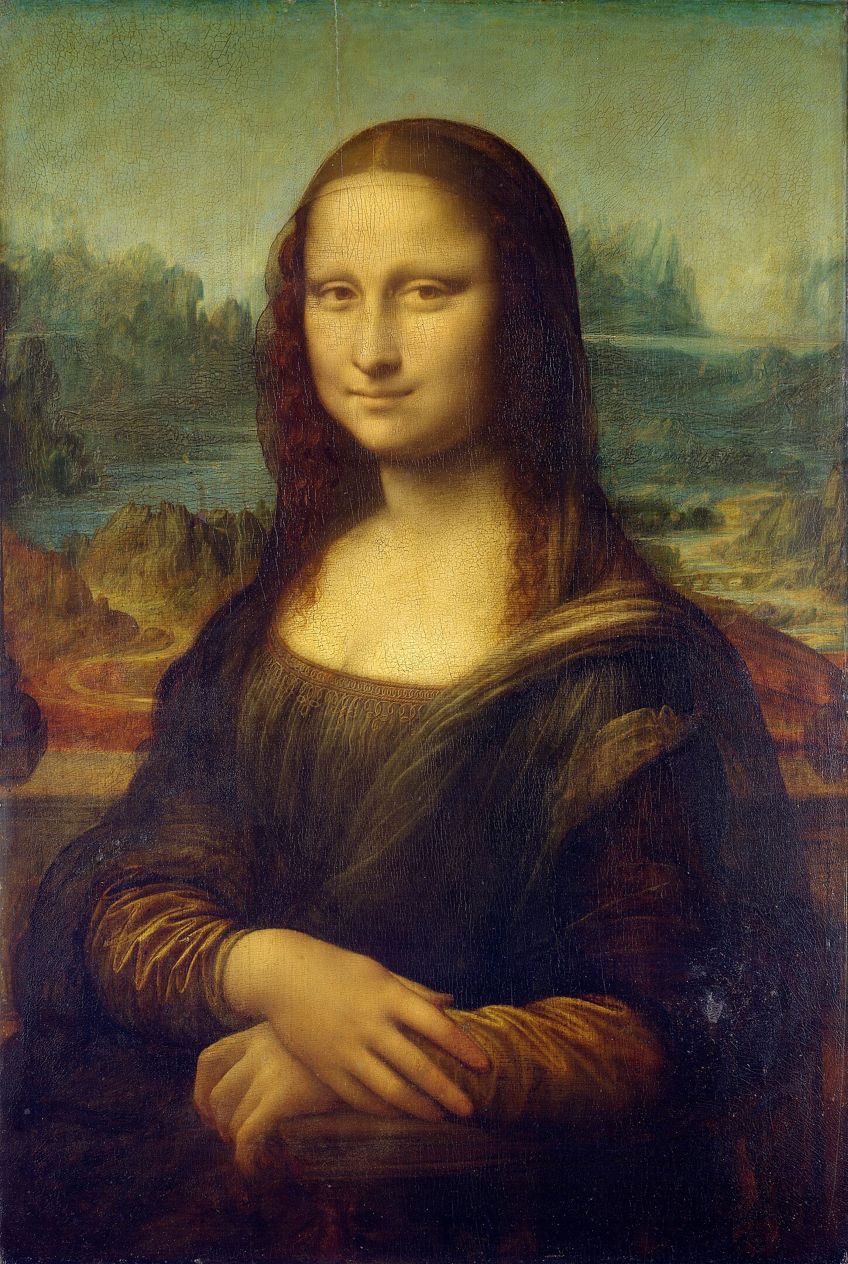 The Mona Lisa (c. 1503–1516) by Leonardo da Vinci; Leonardo da Vinci, Public domain, via Wikimedia Commons
The Mona Lisa (c. 1503–1516) by Leonardo da Vinci; Leonardo da Vinci, Public domain, via Wikimedia Commons
As painting matured in the Renaissance, artists explored new themes such as still-life and mythology, which allowed artists to expand their content and style, and produce new styles informed by Mannerism and Baroque art. Towards the 19th century, Neoclassicism dominated the art scene and drew from classical antiquity to emphasize clarity and order in art. Significant painters of the Renaissance include figures like Michelangelo Merisi da Caravaggio (1571-1610), Peter Paul Rubens (1577-1640), Artemisia Gentileschi (1593-1656), Diego Velázquez (1599-1660), and Rembrandt van Rijn (1606-1669).
Modern Painting
In 1829, the first photograph was produced and marked a period of re-evaluation of painting and its ability to capture reality. The late 19th century is said to be the birthplace of modern painting, which was fueled by the art styles of Impressionism that emphasized light and color. The 20th century saw many art movements driven by new painting styles, including Cubism, Fauvism, Dadaism, and Expressionism, which challenged the views of the Renaissance and favored the value of artistic concepts.
A few famous painters of this era include figures like Pablo Picasso (1881-1973), Georgia O’Keeffe (1887-1986), Salvador Dalí (1904-1989), Frida Kahlo (1907-1954), and Jackson Pollock (1912-1956), who all shaped the iconic painting styles of the 20th century.
Contemporary Painting
Contemporary movements such as Digital Realism, street art, urban art, and collage (inspired by the 20th century), found themselves at the forefront of the evolution of painting. Today, one does not necessarily require a tangible paintbrush and canvas to create a painting. With the introduction of new materials and surfaces, the painting evolved to include cutting-edge technologies with traditional styles. Famous painters of the Contemporary era who shaped the current landscape of painting include icons such as Yayoi Kusama (1929-present), Gerhard Richter (1932-present), El Anatsui (1944-present), Kerry James Marshall (1955-present), Jean-Michel Basquiat (1960-1988), and Takashi Murakami (1962-present).
 The Spirits of the Pumpkins Descended into the Heavens (2015) by Yayoi Kusama; Ncysea, CC BY-SA 4.0, via Wikimedia Commons
The Spirits of the Pumpkins Descended into the Heavens (2015) by Yayoi Kusama; Ncysea, CC BY-SA 4.0, via Wikimedia Commons
Exploring Different Painting Techniques
Now that you have an overview of the development of painting and some of the most iconic figures of painting, you can now appreciate a practical review of the materials, tools, and techniques that one can use in painting. Below, we will explore the different types of paints and their properties.
We will also discuss the materials required for painting and a few techniques for beginners and advanced painters.
Different Types of Paints and Their Properties
There are various types of paints available to Contemporary artists today, with different properties that vary depending on the paint’s use. Below, we have summarized a list of the different types of paints and their properties to help you learn more about the different visual qualities of each.
- Tempera paint is one such paint that has been used since ancient times and consists of pigments combined with a water-soluble binder. Historically, egg tempera paint was also used to produce quick-drying paint that also provided artists with a vivid finish. Tempera painting has a quick drying time and was used in many religious paintings and frescoes.
- Oil paint is one of the most famous types of paint that consists of pigments suspended in linseed oil. Oil paint has a slow drying time and comes in a variety of rich colors. What makes oil paint so alluring is its slow-drying quality, which allows one to edit and adjust elements in a painting without rushing. Oil paints are thinned with linseed oil and provide excellent coverage, making it a popular choice for artists working in traditional media.
- Acrylic paint consists of pigments fused with an acrylic polymer emulsion and tends to dry much quicker than oil paint. Acrylic paint is normally water-resistant after it dries and offers artists plenty of versatility. Acrylic paint can be thinned with water or mixed with textured additives to make it thicker or add texture. What makes acrylic paint so appealing is that it can be used on a variety of surfaces and has a fast drying time.
- Watercolor paint is perhaps one of the most elegant types of paint since they are applied in transparent layers, which requires a lot of patience and an in-depth knowledge of color theory. Watercolor paints are water soluble and can produce beautiful translucent effects that are used to paint landscapes and illustrations. Watercolor was commonly used in East Asian art.
- Gouache paint is similar to watercolor paint, however, it has a higher concentration of pigment with an added white pigment, which offers a matte finish and extra opacity. Many artists use gouache in graphic design and illustration due to its opaque properties and ability to illustrate flat colors with enough pigmentation.
- Enamel paint is an oil-based paint that consists of pigments mixed with resin or varnish. Enamel paint is significantly more durable than any other type of paint and offers multiple types of finishes such as matte, metallic, and glossy. This type of paint is commonly used to paint ceramics, glass surfaces, or metal.
- Chalk paint is another less common type of paint that produces a matte finish and provides a velvet texture. Chalk paint is often used in home décor projects on furniture and is a water-based paint.
- Latex paint is another popular choice for many artists and creatives who use the paint for home décor across interior and exterior spaces. Latex paint has many properties that make it appealing to artists since it is not only water-soluble but is also less toxic than other paints. Latex paint offers a relatively quick drying time, and low odor, and is a durable environmentally-friendly paint that can withstand mildew and everyday wear and tear. Additionally, latex paint is also resistant to fading or yellowing and boasts a variety of finishes.
- Water-mixable oil paint is another excellent choice for artists since it is a water-soluble oil paint that can be thinned using water instead of solvents such as turpentine, which is toxic to inhale. This type of paint has a buttery texture with a slow drying time, only with the convenience of water-based paint.
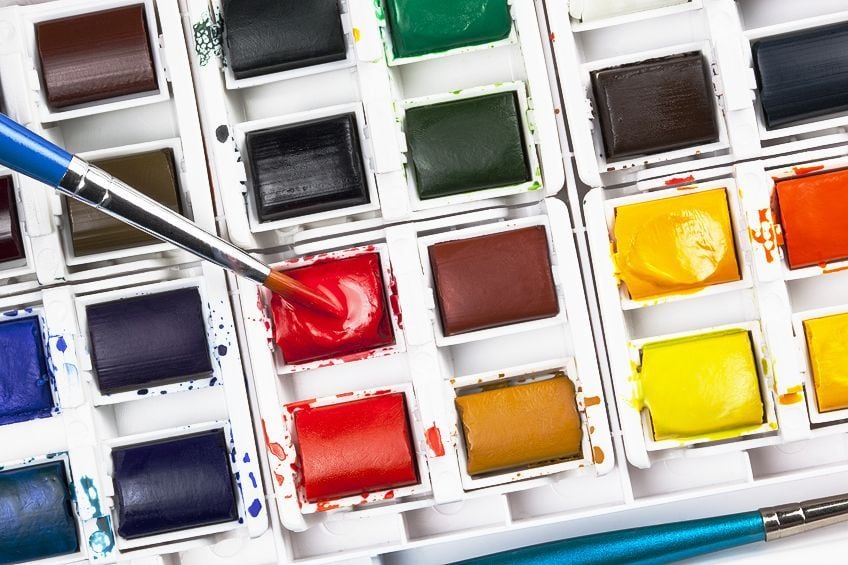
Tools and Materials Required for Painting
Painting typically requires a variety of basic tools and materials, including your choice of paint along with paint brushes of varied sizes. Among the essential tools and materials is a palette board or palette paper, on which you will mix and blend your paint. While paper is a basic material used for beginners, one can also find canvas paper or pre-stretched canvas to start painting on. Additional materials include solvents such as turpentine, linseed oil, or water, and mediums to extend or modify the paint’s properties. One would also be wise to include rag cloths or paper towels to wipe surfaces and clean brushes.
Other useful tools and materials that one can use in painting include masking tape, masking fluid, an easel, and charcoal for preparatory sketches.
Basic Painting Techniques for Beginners
There are many simple painting techniques that one can explore in art. Below, we will summarize the different painting techniques that are beginner-friendly, which will allow you to explore your style!
- Wet-on-dry application: One can practice this technique by applying paint onto a dry surface to allow for controlled layering.
- Wet-on-wet application: This technique involves applying wet paint onto a wet surface to produce marks that create a soft aesthetic and provide a blended effect.
- Impasto: The impasto technique is perhaps one of the most popular painting techniques used by many artists to add dimension and texture to a painting. This technique involves the thick application of paint, sometimes layered over to create a rough and three-dimensional surface.
- Stippling: This painting technique is simple and involves the creation of a pattern or texture using small and distinct dots. Stippling is a method applied in Pointillist paintings, most notably in the works of Georges Seurat.
- Sgraffito: The sgraffito technique involves the act of scratching over wet paint to reveal the surface or visual component beneath it. One can apply multiple layers of paint to a surface with lengthy drying times on the first layer, and thereafter remove aspects of the last layer. This is a subtractive technique that is also used in printmaking.
- Glazing: This technique can be used in different parts of a painting to add dimension and depth to a composition. Glazing involves the addition of transparent or opaque layers of paint over dry layers to enrich the painting.
- Blending: This technique is used to merge hues and create gradients between colors. Blending produces smooth transitions and can be executed gradually to achieve a softer finish.
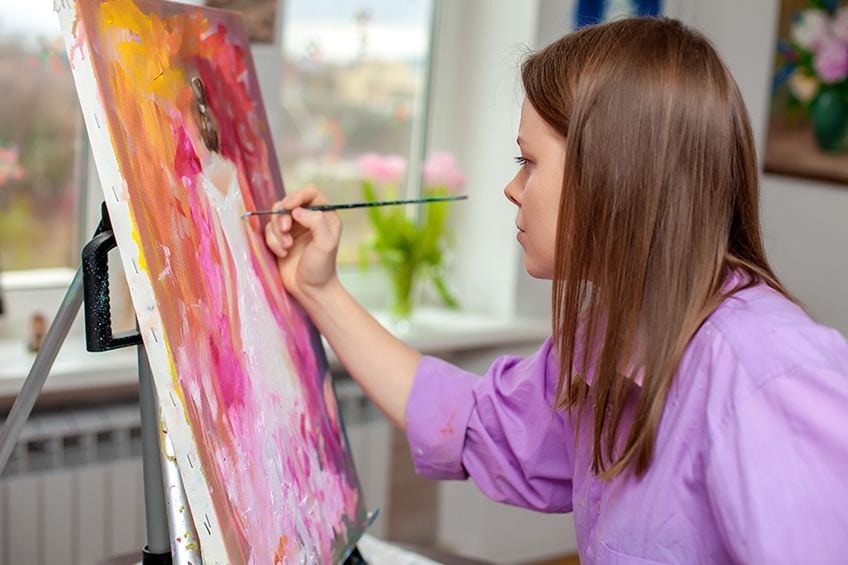
Advanced Painting Techniques for Experienced Artists
While mastering each basic painting technique takes time, patience, and regular practice, many experienced artists continue to rely on the basic techniques to enhance their artworks.
Below, you will find a selection of techniques that experienced painters adopt once they have mastered the basics.
- Grisaille: This technique refers to a monochromatic underpainting method that relies on the various shades of gray to establish the underlying values of each color in the painting. This method is used to create depth and value before applying the layers of color.
- Alla prima: This technique is also understood as direct painting and requires the painting to be completed within one session. Alla prima is a quick process that requires one to capture the immediacy of the subject, which relies on a trained eye and confident hand.
- Chiaroscuro: This classical method was used by the famous Renaissance painter Caravaggio, who created strong contrasts between light and dark colors in a painting. This provides depth and a sense of volume and drama in a composition.
- Encaustic: This painting technique involves the mixture of pigments with heated beeswax, which produces a rich and textured surface. The colors fused with beeswax also remain vibrant, which adds to the painting’s unique finish.
- Fumage: This painting technique involves the creation of images on a canvas by exposing the surface to smoke or soot. This method enables artists to manipulate the patterns on the canvas and produce abstract compositions that cannot be replicated in the same way.
- Collage: While this technique can appear simple, the selection and strategic use of collage in painting takes an experienced eye for detail, texture, and dimension. Collage includes the use of various materials, such as paper, textiles, and found objects to create a visually striking and balanced artwork. Collage can involve the layering of multiple materials and requires one to have an in-depth understanding of the relationships between the paint, material, and the cohesion of objects on a single surface.
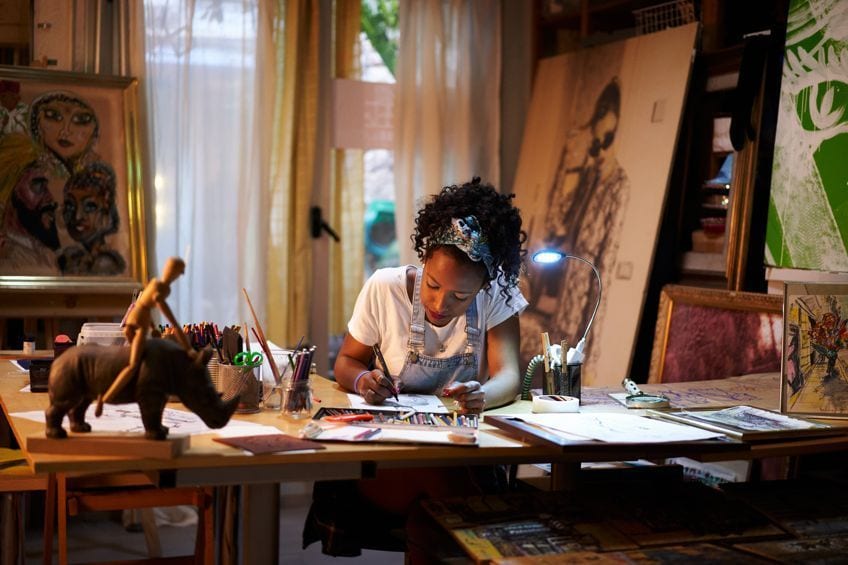
Now that you have a thorough understanding of painting and the techniques involved in creating paintings, you can be confident in commencing your practice. Remember that one should always trust the process and continue to feed one’s mind with knowledge about the mediums that shape our art.
Frequently Asked Questions
What Is Painting?
The process of painting is described as the act of applying pigment, color, or paint to a surface. Paints are commonly applied with a brush and can include other tools such as sponges, palette knives, and airbrushes. Painting describes both the act of painting and the product of it, which is known as an artwork.
Who Are the Three Most Famous Painters?
Among the many famous painters in art history are figures such as Leonardo da Vinci, Michelangelo, and Rembrandt. Each artist is recognized for their contribution to painting in their respective art movements and has proved incredibly influential in the field of painting.
Why Is Painting an Important Art Form?
Painting, as an art form, is considered to be important for many reasons. These include painting as a form of personal expression and a means of communicating to society the significance of elements such as composition, color, and forms, which inform the symbolism embedded in artworks. Artists can express their thoughts or ideas about the world around them and use painting to define new art styles.
Larissa Meyer is a 32-year-old mother from Michigan and creative spirit since childhood. Her passion for painting and drawing has led her to an education as an illustrator and a career as a freelance graphic designer. She has a Bachelor of Fine Arts in Illustration and a degree in Graphic Design. Larissa is a talented artist who is able to master a wide range of styles and techniques to bring her artistic vision to life. Her greatest passion is currently fluid painting and epoxy resin art. Larissa’s love for art and her knowledge and experience in illustration make her the perfect Creative Director for our fluid-painting.com team. She is the creative head of our team and shares her passion and knowledge with our community through articles and tutorials.
As a mother of a 2-year-old daughter, Larissa also understands the importance of fostering creativity in early childhood. She uses her experience and knowledge to help other parents inspire their children and develop their artistic skills as well.
Learn more about Larissa Meyer and about us.

